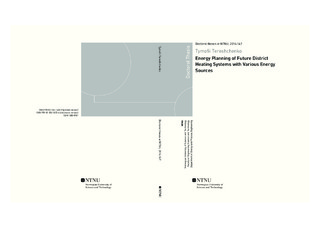| dc.description.abstract | The successful development of a district heating (DH) system requires deep understanding of operation issues. This includes the integration of new energy conversion technologies, control strategies, and economic issues. Different energy sources can be utilized as a primary energy input in the DH systems. Nowadays, the focus is on reduction of the use of fossil fuels and a shift toward renewable alternatives. New developments in the building sector emphasize the application of new design forms and materials, trying to reach the desired lower certified level of energy use. This is corroborated by European Directive 2010/31/EU, stating that, by the end of 2020, all new buildings should be nearly Zero-Energy Buildings (nZEB). The directive pushes society toward the rational use of energy in the building sector. In its deeper analysis, it can be concluded that the DH companies experience the reduction in heat demands. Furthermore, much discussion has taken place regarding the lowering of temperature levels in the DH network, allowing better energy utilization and the application of low temperature excess heat. In this context, DH systems and energy units are becoming more complex and sophisticated; therefore, the need for profound knowledge of DH operation arises.
This thesis discussed different issues associated with the operation of energy production units integrated to DH systems. Therefore, the studies presented in this thesis shed light on operation of DH systems under the three main points. The first concentrates on customers’ impact
on DH operation. Hence, the reduction in heat demand, different temperature levels, and available control strategies were analyzed. Next, debates were held about the investment decisions that DH companies face when there is a need to extend or develop energy production units. This included the analysis of units’ sizes, heat load fluctuations, fuel price volatility, mutual effects, and technical limitations. The third research point demonstrated how DH operation could question existing legislation guidelines.
In this thesis, Aspen HYSYS process simulation software was employed for the simulation of energy units. Data post-processing was carried out by MATLAB. Sensitivity analyses of the performed studies were performed under the annual heat and electricity loads obtained from the energy monitoring system of the university campus.
The results found that effective plant operation was highly dependent on heat load profile.
The operation of a Combined Cycle Power Plant (CCPP) connected to low energy building stock
was rather difficult. This means that the CCPP is suitable for high-density heat areas, while it has
poor energy performance indicators in low heat density areas.
Further, the analysis of possible solutions for supplying the DH system with several energy supply technologies found that proper evaluation of all the risks associated with the choice of installation and investment could lead to significant savings in a long-term operation of a DH system. This is highly relevant due to changes in heat load profiles, legislation amendments, and improvements in energy saving measures.
The existing method for heat supply optimization, which is based on the methodology of finding the optimal generation mix in some target year, is found to be a simple way to deal with the costs and operation issues. A number of additional important factors affecting plant operation are missing.
Analysis of the allocation factors found that the allocation of fuel, emissions, and operation expenses in Combined Heat and Power (CHP) plants, performed according to standard EN15603 was sensitive when annual operation was considered. Therefore, the decision regarding allocation methods should be carefully analyzed before implementation in the standards, pricing models, and different policies. Mistaken allocation could disable benefits from cogeneration technology and distribution systems. The results of the allocation analysis presented in this work could be used by designers of CHP systems and policy makers, as a tool for developing an emission trading system for CHP plants and for the pricing of heat and power.
The literature review of different factors leading to the premature breakup of the distribution network showed that it is very important to be aware of existing degradation mechanisms and prevent them in good time.
Operation of the DH system with the various energy sources, following different control strategies, is a rather complicated process. In addition, legislation amendments put an extra pressure on DH companies. Based on the process simulation and feasibility studies, the presented information fits well within the issues associated with the operation of DH systems. Further, the performed studies provided valuable information, applicable for operation analysis, control strategy development, and growth of DH networks. | nb_NO |
